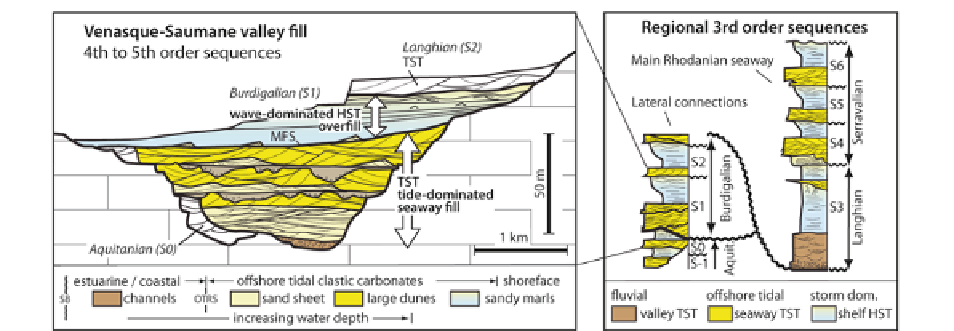Geology Reference
In-Depth Information
Fig. 13.27
Succession of deposits in the Miocene foreland-basin
seaway of SE France, showing the influence of changing sea level
and morphology on the development of tidal deposits. (
Right
)
Succession of third-order sequences (S1-S6), each of which is
composed of a lower, bioclastic-rich transgressive (
TST
) deposit
formed by tidal dunes, and an upper marly, wave-influenced high-
stand (
HST
) deposit. The sequence boundaries are possibly suba-
erial erosion surfaces, but they were intensely scoured by strong
tidal currents during transgression, forming tidal ravinement sur-
faces. The thickness of the sequence set exceeds 100 m in most
places. (
Left
) Detailed architecture of the Saumane-Venasque sea-
way filled and overtopped by sequence S1. When relative sea level
was low and water was confined to the valley, the deposits were
tide-dominated, coarse-grained bioclastic material. Once the
water level rose above the interfluves, the cross-sectional area
increased dramatically, so that tidal-current strength decreased,
and the deposits became fine grained and wave-dominated.
OTRS
offshore tidal ravinement surface. This depositional pattern
is repeated in each of the six sequences shown in the
right-hand
figure (After Besson
2005
and Besson et al.
2005
)
perhaps more than once during a major transgression.
This might have been the case for the English Channel
during the last sea-level rise. After a first 'tidal cli-
max' early in the post-glacial transgression (i.e., at ca.
16 ka BP), an abrupt loss of tidal resonance was
recorded that might correspond to the end of active
up-building of the Late Pleistocene Celtic Banks
(Reynaud et al.
1999b
; Uehara et al.
2006
). Much
more recently, a second phase of strong tidal action
has occurred in the Normandy-Brittany Gulf and
Eastern Channel, bringing about the formation of a
second set of tidal ridges at a much more landward
location (Reynaud et al.
2003
; Fig.
13.25
).
In the case of broad seaways, the tidal influence is
likely to increase with falling sea level, because nar-
rowing of the seaways favors the constriction of tidal
flows and restricts the fetch of wind waves (Yoshida
et al.
2007
). A narrowing of the seaway due to progra-
dation of its margins would have the same effect, even
if water depths were increasing (Van der Molen et al.
2004
). The Cretaceous Western Interior Seaway of
Northern America provides examples of this type of
response to sea-level change, with lowstand deposits
being tide-dominated, whereas highstand deposits are
wave-dominated (see Chap. 17). In a different example,
paleotidal modeling by Wells et al. (
2007
) showed that
tidal circulation inside the Late Pennsylvanian
Midcontinent Seaway of America would have been
diminished during times of maximum flooding, pro-
moting the development of black shales, whereas the
lowstand to transgressive intervals, when the seaway
was narrower, favored the development of large tides in
the eastern embayment of the seaway, as recorded by
the coeval fluvial-estuarine transition in Kansas (Lanier
et al.
1993
). At a smaller scale, the same interpretation
is provided by the Miocene incised valleys/seaways of
SE France (Besson et al.
2005
; Reynaud et al.
2006
).
During highstands, the valley interfluves are flooded
creating broad seaways in which deposition consisted
of wave-influenced carbonate-rich mudstones with
minimal tidal influence (Fig.
13.27
). By contrast, when
sea level fell and the interfluves became emergent, flow
constriction within the valleys lead to the accumulation
of localized tide-dominated deposits. Other examples
of water-depth control on the strength of tidal currents
in seaways are provided by Anastas et al. (
2006
;
Oligocene of New Zealand) and Surlyk and Noe-
Nygaard (
1991
; Jurassic of Scotland; Fig.
13.28
).

